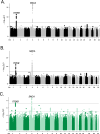This is a preprint.
Genotype-phenotype association study conducted on LARGE-PD reveals novel loci associated with Parkinson's Disease
- PMID: 40791673
- PMCID: PMC12338945
- DOI: 10.1101/2025.07.18.25331793
Genotype-phenotype association study conducted on LARGE-PD reveals novel loci associated with Parkinson's Disease
Abstract
Background: The Latin American Research Consortium on the Genetics of Parkinson's Disease (LARGE-PD) is a multicenter collaboration aimed at understanding the genetic architecture of Parkinson's disease (PD) in this underrepresented population using data from 15 countries across the Americas and the Caribbean. In this study, we conducted the largest genome-wide association studies (GWAS) for PD susceptibility in Latin Americans.
Methods: We analyzed genotype data from LARGE-PD Phase 1 (n = 1,498) and Phase 2 (n = 4,401) using multiple GWAS approaches: SAIGE, which incorporates a genetic relationship matrix in the model; ATT, which includes global ancestry on the model; TRACTOR, which splits allele dosages by ancestry to detect ancestry-specific risk loci; and admixture mapping. We also assessed linkage disequilibrium (LD) patterns and performed Meta-Regression of Multi-AncEstry Genetic Association (MR-MEGA), integrating data from both LARGE-PD phases and two South Asian GWAS.
Results: We identified PD-associated loci on chromosomes 1 and 4. Our results replicated previous findings, including the well-established SNCA variant rs356182-A (OR = 1.517, p = 1.62×10-16). Notably, we identified a locus in ITPKB (rs117185933-A, OR = 1.75, p = 3.8×10-12), which had the highest CADD Phred score (17.92, top ~3% most deleterious) among all candidate variants, suggesting strong functional relevance. Functional annotation predicted that this variant may create a premature start codon in the 5' UTR of ITPKB. Although rs117185933-A is in high LD (r2 > 0.8) with a variant previously reported by Kishore et al., our LD analysis and MR-MEGA results indicate that this signal is correlated with ancestry heterogeneity and likely represents an independent PD risk locus and a novel putative causal variant. This variant is most frequent in Peruvians from the 1000 Genomes Project (MAF = 0.20) and more common in admixed American populations in gnomAD (MAF = 0.0835), but nearly absent in non-Finnish Europeans (MAF = 0.0002).
Conclusion: We identified PD-associated variants in SNCA and ITPKB, the latter not previously reported in European-ancestry studies. The ITPKB variant may lead to a start codon gain in a gene with known protective effects against α-synuclein aggregation in vivo and in vitro models. These findings underscore the critical importance of including underrepresented populations in genetic research to uncover ancestry-specific risk loci and advance precision medicine for Parkinson's disease.
Conflict of interest statement
Conflict of interest Mayela Rodríguez-Violante has received honoraria from Ferrer and Zydus, and educational grants from Medtronic and Boston Scientific. All other authors declare that there are no conflicts of interest.
Figures


References
Publication types
Grants and funding
LinkOut - more resources
Full Text Sources
Research Materials
Miscellaneous
